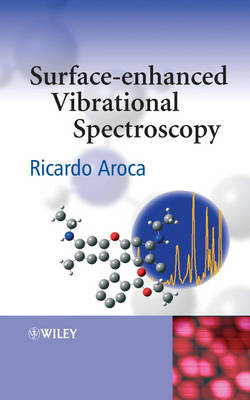
Surface-Enhanced Vibrational Spectroscopy
John Wiley & Sons Inc (Verlag)
978-0-471-60731-1 (ISBN)
Surface Enhanced Vibrational Spectroscopy (SEVS) has reachedmaturity as an analytical technique, but until now there has beenno single work that describes the theory and experiments of SEVS.This book combines the two important techniques of surface-enhancedRaman scattering (SERS) and surface-enhanced infrared (SEIR) intoone text that serves as the definitive resource on SEVS.
* Discusses both the theory and the applications of SEVS andprovides an up-to-date study of the state of the art
* Offers interpretations of SEVS spectra for practicinganalysts
* Discusses interpretation of SEVS spectra, which can often bevery different to the non-enhanced spectrum - aids the practicinganalyst
Professor Ricardo Aroca is based in the School of Physical Sciences, University of Windsor, Canada. He has almost 250 publications and his research interest are i) single molecule detection, ii) nanostructures for surface-enhanced spectroscopy and iii) in hydrogen storage materials.
Preface.
Acknowledgments.
Glossary.
1. Theory of Molecular Vibrations. The Origin of Infrared andRaman Spectra.
1.1 Electronic, Vibrational, Rotational and TranslationalEnergy.
1.2 Separation of Nuclear and Electronic Motions.
1.3 Vibrations in Polyatomic Molecules.
1.4 Equilibrium Properties. Dipole Moment andPolarizability.
1.5 Fundamental Vibrational Transitions in the Infrared andRaman Regions.
1.6 Symmetry of Normal Modes and Vibrational States.
1.7 Selection Rules.
1.8 The Example of ab initio Computation of the Raman andInfrared Spectra.
1.9 Vibrational Intensities.
1.10 Definition of Cross-Section.
1.11 The Units of Energy and Force Constants.
References.
2. The Interaction of Light with Nanoscopic Metal Particlesand Molecules on Smooth Reflecting Surfaces.
2.1 Electric Permittivity and Refractive Index.
2.2 Propagation of Electromagnetic Waves and the OpticalProperties of Materials.
2.3 Scattering and Absorption by Nanoscopic Particles.
2.4 Reflection-Absorption Infrared Spectroscopy on SmoothMetal Surfaces.
References.
3. Surface-Enhanced Raman Scattering (SERS).
3.1 Electromagnetic Enhancement Mechanism.
References.
4. Chemical Effects and the SERS Spectrum.
4.1 Physical and Chemical Adsorption.
4.2 SERS/SERRS of Physically Adsorbed Molecules.
4.3 SERS of Chemically Adsorbed Molecules without ElectronicResonance Excitation.
4.4 SERS of Chemically Adsorbed Molecules with Charge TransferExcitation.
4.5 Metal-Molecule or Molecule-Metal ChargeTransfer.
4.6 SERRS from a Surface Complex.
References.
5. Is SERS Molecule Specific?
References.
6. SERS/SERRS, the Analytical Tool.
6.1 Average SERS on Metal Colloids. Preparation andProperties.
6.2 Metal Colloids. The Background SERS.
6.3 Metal Colloids. Maximizing the Average SERS in Solution.
6.4 Average SERS on Metal Island Films.
6.5 Average SERS on Rough Electrodes.
6.6 Ultrasensitive SERS Analysis and Single MoleculeDetection.
6.7 Uniqueness of Ultrasensitive Chemical Analysis. The MovingTarget.
6.8 Applications and Outlook.
References.
7. Surface-Enhanced Infrared Spectroscopy.
7.1 Overview.
7.2 Theoretical Models for SEIRA.
7.3 SEIRA-Active Substrates.
7.4 Interpretation of the Observed SEIRA Spectra.
7.5 Applications of SEIRA.
References.
Index.
| Erscheint lt. Verlag | 31.3.2006 |
|---|---|
| Verlagsort | New York |
| Sprache | englisch |
| Maße | 160 x 234 mm |
| Gewicht | 510 g |
| Themenwelt | Naturwissenschaften ► Chemie ► Physikalische Chemie |
| ISBN-10 | 0-471-60731-2 / 0471607312 |
| ISBN-13 | 978-0-471-60731-1 / 9780471607311 |
| Zustand | Neuware |
| Haben Sie eine Frage zum Produkt? |
aus dem Bereich


